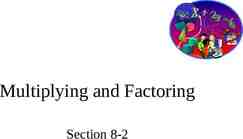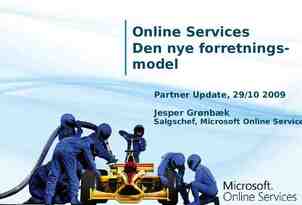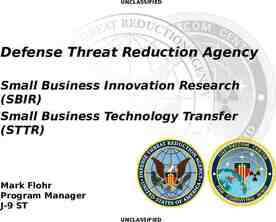Hearing Conservation & Noise Control Bureau of Workers’ Compensation
29 Slides1.50 MB

Hearing Conservation & Noise Control Bureau of Workers’ Compensation PA Training for Health & Safety (PATHS) 29 CFR 1910.95 PPT-017-03 1

Why Hearing Conservation? Huh? What? It’s the “LAW” Quality of Life Hearing Loss is Gradual/Painless PPT-017-03 2

Anatomy of the Ear PPT-017-03 3

Types of Hearing Loss Conductive – Occurs in ear canal, drum, ossicles Central – Damage to auditory nerve Sensorineural – Nerve damage in cochlea PPT-017-03 4

Other Health Affected PPT-017-03 5

Degree of Risk Frequency – How often workers exposed Intensity – How loud Duration – How long Individual Variability – Person’s resistance PPT-017-03 6

Decibel The ear has the remarkable ability to handle an enormous range of sound levels. In order to express levels of sound meaningfully in numbers that are more manageable, a logarithmic scale is used, rather than a linear one. This scale is the decibel scale used to express the ratio of two values of a physical quantity, often power or intensity (in this case, sound). Zero decibels (0 dB) is the quietest sound audible to a healthy human ear. From there, every increase of 3 dB represents a doubling of sound intensity, or acoustic power. PPT-017-03 7

How Loud is Loud? Jet engine 140 db Threshold of Pain 125 db Pneumatic hammer 110 db Compressed Air 105 db Punch Press 95 db Lawn Mower 90 db Conversation 65 db PPT-017-03 8

Hearing Protection Advantages and Disadvantages Cotton Balls – Virtually no protection Canal Blockers/Ear Pods – Very convenient for intermittent noise Readily available around neck when not in use Only cover opening of ear canal Lower attenuation than most earplugs Some noise transmission through band PPT-017-03 9

Care & Maintenance Canal Blockers/Ear Pods Check before each use for damage Clean and replace pods regularly Do not overstretch band PPT-017-03 10

Hearing Protective Equipment Advantages and Disadvantages Ear Plugs Comfortable for extended use Disposable earplugs available Cooler in hot/humid environments Single-use foam plugs can provide highest levels of attenuation Can be difficult to insert & annoying to wear PPT-017-03 11

How to Insert Earplugs 1. Roll the earplug into a tight cylinder 2. Lift the top of your ear to open the canal 3. Insert earplug into the open canal 4. Hold earplug in place until the foam expands 5. Repeat Steps 1 – 4 to insert into other ear PPT-017-03 12

Care/Maintenance Earplugs Dispose of single-use earplugs daily Clean multiple-use earplugs with mild soap and water, dry thoroughly Inspect multiple-use earplugs for dirt, cracks or hardness, replace if damaged PPT-017-03 13

Hearing Protective Equipment Advantages and Disadvantages Ear Muffs Easy to get proper fit Good for intermittent noise Radio & electronic options Can feel hot/heavy with extended wear Must determine compatibility with other PPE PPT-017-03 14

Care/Maintenance-Ear Muffs Clean ear cushions and headband regularly with mild soap and water Replace ear cushions and foam inserts every 4-6 months with normal wear, more often with heavy use/extreme conditions Do not overstretch headband PPT-017-03 15

dBA vs. dBC The A-weightings and C-weightings refer to different sensitivity scales for noise measurement. “A” scale follows the frequency sensitivity of the human ear at low levels. Is the most commonly used weighting scale, as it also predicts quite well the damage risk of the ear. Sound level meters set to the A-weighting scale will filter out much of the low-frequency noise they measure, similar to the response of the human ear. “C” scale follows the frequency sensitivity of the human ear at very high noise levels. “C” scale is quite flat, and therefore includes much more of the low-frequency range of sounds than the A scales. PPT-017-03 16

“Safety Factor” NRR Noise Reduction Rating (NRR) OSHA protocol For “A” scale measurements, NRR minus 7 Example: Noise exposure 92 dBA Manufacturer’s NRR 15 15 – 7 8 (effective noise exposure reduction) 92 – 8 84 dBA (noise exposure at ear) PPT-017-03 17

NRR Determination Per OSHA If using dB(A) scale: Noise level minus [NRR minus 7 divided by 2] Noise level at ear ex. Noise Level 98 dBA NRR 25 dBA 98 - [25-7/2 9] 98-9 89 dBA If using dB(C) scale: Noise level minus [NRR divided by two] Noise level at ear ex. Noise Level 98 dB NRR 25 dB 98 – [25/2 12.5] 98-12.5 85.5 dB PPT-017-03 18

Exposure Limits Time Weighted Average (TWA) Time Weighted Average Sound Level: “That sound level, which if constant over an 8 hour exposure, would result in the same dose as is measured.” To determine TWA if working in different areas with different noise level readings over 8 hour work shift: Use 1910.95, Appendix A, Table G-16A Table A-1 PPT-017-03 19

Permissible Noise Exposure* 102 105 110 115 dB dB dB dB 1.5 hours 1.0 hours 30 minutes 15 minutes 90 dB 8.0 hours 92 dB 6.0 hours 95 dB 4.0 hours 97 dB 3.0 hours 100 dB 2.0 hours *At or above controls: Engineering, Administrative, PPE PPT-017-03 20

Exposure Limits If exposure to 8 hour Time Weighted Average (TWA): ACGIH 85 dBA (action level) NIOSH 85 dBA (action level) OSHA 84 dBA: nothing required 85 – 89 dBA: - Monitoring - Testing - Protection - Training - Recordkeeping 90 dBA (Permissible Noise Exposure Limit) PPT-017-03 21

Noise Monitoring Required by the OSHA standard to identify all noise at or above 85 dBA Monitoring must be performed: o Whenever production is increased o Equipment added that could increase noise level PPT-017-03 22

Audiograms Audiograms are required every year to identify if there has been a loss of hearing The solid line shows a normal result with no hearing loss. The dotted line represents a typical noise induced hearing loss (NIHL) PPT-017-03 23

Training Requirements Annual Training Hearing Conservation Elements Hearing Conservation Program Hearing Protectors Used PPT-017-03 24

Recordkeeping Monitoring records (Keep for 2 years) Audiometric testing records (Keep for period of employment) PPT-017-03 25

Noise Control Engineering (e.g. sound barriers) Administrative (e.g. worker rotation) Personal Protective Equipment (PPE) ear plugs, ear muffs) PPT-017-03 (e.g. 26

What’s Your Company Doing? To Control Noise Exposure? Monitoring? Engineering? Administrative? PPE? If you’re not sure check with your Supervisor and find out! PPT-017-03 27

Contact Information Health & Safety Training Specialists 1171 South Cameron Street, Room 324 Harrisburg, PA 17104-2501 (717) 772-1635 [email protected] Like us on Facebook! https://www.facebook.com/BWCPATHS PPT-017-03 28

Questions PPT-017-03 29






